Fighting Back At 40,000 Feet
Part 2 - Group Principles, Individual Strategies
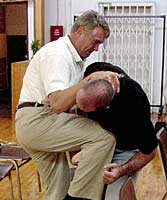 |
Don’t forget your knees
and elbows when fighting back |
By Christopher Caile
You’re comfortably strapped in your seat, 40,000 feet in the clouds
and day dreaming --- then suddenly you are jolted awake. There’s
commotion, men yelling and screams: “Stop him, stop him,”
and “Oh, my God.”
“Your primary objective is to protect the integrity
of the cockpit, the pilots’ lives and their control
over the plane…" |
|
There’s a man with a knife, and he might not be alone. The hard
reality is that after 9/11 future terrorist attempts to take over or blow
up an airplane are still possible. Although it is unlikely that you will
actually be personally involved, this article will give you some pointers
– just in case.
Part
1 of this series discussed this possible eventuality, and the dilemmas
of choice and morality passengers would face if terrorists struck. If
terrorists attempt to take over your flight, your primary objective is
to protect the integrity of the cockpit, the pilots’ lives and their
control over the plane, or barring that, retaking control of the cockpit
and its controls from the terrorists. Crashing the plane to deny the terrorists’
ultimate goal is the last and obviously least desirable outcome. It also
forces the issue of where and who might get killed on the ground.
But the terrorists might have other plans. Their sole objective may be
just to use a bomb to crash the plane and kill all on board. We have also
become so polarized by 9/11 that we might not recognize the “classic”
pre-9/11 type of hijacker, whose aim was to use passengers, crew and the
plane as a bargaining chip.
This article will discuss some general strategies, tactics and methods
passengers might employ in several of these scenarios. Included are principles
of group action as well as individual strategies and a few concepts of
action. The emphasis is on basics and group dynamics: how two or three
people, as well as a larger group, can fight back in a coordinated action
– a team approach.
Group action does not require expert self-defense skills. So, if you’re
expecting to learn fancy Bruce Lee-like jumping kicks, or learn how to
do Jackie Chan flip-like moves on an Osama bin want-to-be, you won’t
find these here. In Part 3, I will list various improvised weapons, shields
and artillery that will assist you.
Over 700 million passengers board US airlines annually. The chances that
anyone on your plane is a danger to you is minimal. So keep your perspective
and don’t overreact. But, there are some precautionary measures
you can take.
First, you should think ahead of time about what you might do and what
weapons you could use, just in case. Another critical element is awareness.
Pay attention to those seated next to and around you. Talk to them. Observe
their behavior. We know weapons can get on a plane, and Abdel Rahim, the
alleged shoe bomber, illustrated that explosive materials can too.
The observations of passengers and crew are the final line of defense
against use of such items. So be aware of people who seem to be together,
but try to act like they aren’t; anyone who looks suspicious; takes
suspicious actions; or acts especially nervous.
“The more people who react and resist together,
the better the chance of overwhelming the enemy.” |
|
If someone sneaks a small bomb onboard, or tries to ignite it, or press
it into the cabin wall, it will be up to a passenger or flight attendant
to notice and take action.
You can also request seating on an aisle or in an exit door row in order
to be in the best position to respond if need be. And, if you are traveling
with others, discuss what you might do if action is required. One person
might say, “I’m on the aisle, so if a terrorist is within
reach, or moves past me, I will jump him from behind, and you grab his
legs so we can hold him down.”
A basic premise of this article is: the more people who react and resist
together, the better the chance of overwhelming the enemy. If ten, twenty
or more passengers are motivated and able-bodied, they should be able
to overpower a smaller group of terrorists even if they are armed with
knives, box cutters, or even a gun. That’s why the 9/11 terrorists
chose to attack early morning flights which had fewer passengers –
a smaller pool of potential resistors.
The second premise is: the more coordinated the effort, and the better
armed the passengers are, the better chance of success. You can fight
back just by yourself, but acting with one, two or three others, or responding
in a larger group, is much more effective. This group action compensates
for lack of individual self-defense skills, although onboard the plane
there may be off duty law enforcement personnel or others trained in self-defense.
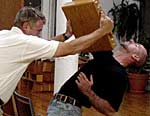 |
Using a brief case as an
improvised weapon |
|
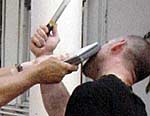 |
| The hard corner
of a computer thrust into an eye is also extremely effective |
|
In a group action any one person can attack, but he or she can also grab,
wrestle, defend, distract, block or smother. Improvised weapons also help
and shields can be used for defense, blocking or smothering operations.
“The more coordinated the effort, and the better
armed the passengers are, the better chance of success.” |
|
Group action includes efforts to isolate targets, coordinate efforts
and/or attack in mass. These aspects will be discussed below.
Action planning might be spontaneous, discussed ahead of time with associates
as suggested, or quickly formulated with others around you. Even four
or five terrorists can’t be everywhere, so there will always be
opportunity for some passengers to do some quick planning.
Pilots, crew members, and air marshals might also get involved. Pilots
might maneuver or dive the airplane to unbalance any terrorists. They
can also depressurize the cabin. Flight attendants may also physically
intervene.
If there are air marshals present, assist them if necessary, but otherwise
get out of the way. They will try to identify targets, and there will
be drawn guns and probably shots (hard rubber bullets). So stay in your
seat, or hit the floor if this occurs. If you remain standing, turn toward
the back of the plane and don’t move toward the cockpit. The air
marshal’s job is to protect the pilots and the cockpit. Don’t
let them mistake you for the target by moving in the wrong direction.
Some strategists have suggested that a terrorist might initially create
a distraction to flush out any air marshals. Once they have sprung into
action, the air marshals can be identified and attacked by other terrorist
members. Air marshals might only get off several rounds from their revolvers
aimed at one target before being overwhelmed by another terrorist nearby.
This scenario illustrates an important principle of group action: isolation.
An air marshal or terrorist is most vulnerable when alone, isolated along
a cabin aisle, or in his or her seat. So if a terrorist is attacking an
air marshal, or someone has jumped up with a weapon or seized a hostage,
a quick response by passengers in the area who intercede might just end
the takeover before it has fully developed. If there are just one or two
terrorists on board, they might be subdued in this way.
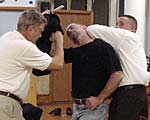 |
While one passenger blocks
a terrorist’s knife with his forearm wrapped in a jacket,
he also punches the attacker’s face. At the same time,
from behind, the terrorist is attacked by another passenger
using an elbow to the head. |
|
 |
| The passenger
behind the attacker continues the action by reaching over
with his fingers to gorge the terrorist’s eyes while
at the same time yanking him backwards. |
|
This “simultaneous action” on the part of passengers is the
second important principle of group action. The concept is very different
from individual self-defense, although individual self-defense skills
are useful too. Here the premise is not focused on individual action,
but multiple people working as a unit to attack, grab, hold, punch, etc,
from all sides at once to overwhelm the target. Anyone can play a roll.
| If you are seated in an aisle seat, your role in
the group action might be to grab an arm or tackle someone from
the side, or push someone into a seat across the aisle where others
can grab him. If someone else is fighting with a terrorist, your
contribution will be a surprise. Someone else behind the terrorist
can at the same time tackle him, or jump on him to pin his arms,
strike him in the back of the neck or head with an elbow, or kick
him in the back of his knees to fell him backwards.
If you are in front of a terrorist, you can kick or strike out,
grab or wrestle. The greatest danger to any passenger is a weapon
such as a knife. So if one is present, and the terrorist is targeting
you, grab something you can use as a shield. The danger will be
only momentary, if others quickly join in. At the same time you
can also counter-attack, either to injure him or force him to keep
some distance. You might target the terrorist’s eyes with
your finger tips or strike out with an improvised weapon.
|
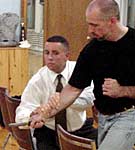 |
An aisle passenger surprises
an armed attacker from the side by grabbing his knife arm.
He could have also tackled the terrorist. |
|
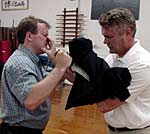 |
A passenger blocks a knife
slash with his forearm protected by his sports jacket wrapped
around it while at the same time attacking a terrorist’s
eyes |
|
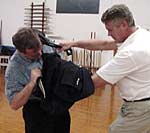 |
While blocking a passenger
strikes out with an improvised weapon, a camera inside waist
pack |
|
Another thing about shields: don’t get fancy. Don’t move
it all around trying to follow the weapon’s path. If the shield
is large, just hold it out. Only a slight adjustment is needed. If only
your forearm is protected, still try to limit any movement to areas directly
to the front, being especially careful to protect your face and neck.
Evidence gathered from Al Qaeda sources suggests that the 9/11 terrorists
were trained to attack primarily facial targets with their box cutters.
The theory was that the sight of blood and pain from facial or neck cuts
would create such shock and trauma that passengers would be intimidated
into inaction.
| Also be sure to keep the insides of
your forearms turned toward you. A shield can help protect, but
not a guarantee against cuts. A cut on the outside of your forearm
will hurt and bleed, but one to the palm side can sever a major
artery as well as tendons that control your hands and fingers. So
keep your forearm turned inward.
Shields are everywhere: a seat cushion (designed to be removed
for floatation uses), bag, or brief case. You can also wrap your
coat or your suit jacket around your forearm to protect it. Larger
shields can also be pushed into people to smother them, or to block
use of their arms. Part 3 will provide more detail on where to find
and make shields and weapons.
|
|
Using a carry on bag
as a shield |
|
Another thing you can do is shout. A quick, powerful shout, known as
a “kiai’ in the martial arts, can produce a momentary “startle
reflex.” This creates a brief opportunity for action. It also helps
fight your own fear. A mind confronted with two inputs can only process
one. This is referred to as “Cognitive Dissidence.” And if
several people shout and yell together, it might just unnerve the terrorists
or at least disrupt their verbal communication.
Another important role in any joint action might be to block a terrorist’s
movement in one direction along an aisle so others can intercede before
he can join others in his group. Here again a shield might be used. You
can also relentlessly kick forward to stop the approaching person. Even
if you are pushed backward and down on your back, you can keep kicking
low with the bottom of your shoes into the terrorist’s knees. This
will impede movement, your body also helping to block the aisle, until
others can join in.
| If you and other passengers are at
a distance from one or more terrorists and others have not engaged
them, another option is to throw things at them – pillows,
a blanket, coats, liquid from cups, a can of soda, a handful of
coins, etc. which will distract their attention, and make them duck,
weave and shield their faces. This creates an opportunity to close
in. Blankets and coats can also be thrown over people to momentarily
confuse them. If passengers can quickly get their arms around a
covered terrorist, the coat or blanket will help smother the terrorist’s
arm movement and cause disorientation if eyesight is blocked.
|
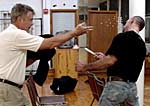 |
A passenger momentary distracts
an attacker by throwing coins from his pocket into his face |
|
How does the airplane’s physical environment affect passengers’
ability to fight back? One negative factor is that the limited space restricts
what techniques a passenger can use. Wide swinging punches or kicking
movements don’t work. The ceilings are too low and you are likely
to hit other nearby passengers or strike overhead storage compartments.
Direct or limited range techniques, however, are effective, such as kicks
to the front or back and downward stomp kicks. So are straight punches,
knees, thrusting attacks with improvised weapons, elbows and head butts.
A positive factor affecting passengers’ ability to fight terrorists
is that the tube-like structure of the plane creates difficult strategic
problems for the terrorists. They may initially be separated by seating,
and their movement is limited to narrow pathways along which you and other
passengers are seated. If fighting begins, their space for movement is
restricted. Their movement can be blocked and the limited width of aisles
can also be used as a tool against them. If they are grouped along an
aisle, they are still vulnerable, one in front of another. And there are
more factors.
| If a terrorist is hurt or stunned and
is tackled to the ground, or has a leg lifted and is dumped backward
into the aisle, he becomes very vulnerable. The aisle works to his
disadvantage because it is difficult for his associates to assist
him. The seats themselves provide a barrier to the sides, while
other passengers can easily block the aisle so associates can’t
get to him.
Once on the ground, a terrorist’s hands, fingers, wrists,
ankles, the head and neck can be targeted and easily injured. So
stomp down, hit or use an elbow. You don’t want to leave a
terrorist physically capable of being a continued threat. If a terrorist
is just knocked down but is not incapacitated, he is still very
dangerous.
|
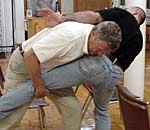 |
A secondary technique is
to grab a leg and dump someone backwards into the aisle so
other passengers can either jump on or strike, kick or stomp
at his hands, face, neck or feet, etc. |
|
This is brutal stuff. You have to be vicious and unrelenting. Your goal
is to hurt, injure or incapacitate. Most people normally think in terms
of punching or striking to the back of the head, temples, side of the
neck, and edge of the jaw next to the ear to stun, or knock out. However,
an improvised weapon can increase the impact and also extend your range.
Think of attacks to the eyes or throat that can affect vision and the
ability to breathe. Also, a stomp on a hand can end the terrorist’s
ability to hold a weapon or grab. A kick into a knee, or a stomp down
on an ankle or toes can limit his ability to walk. In short, you can knock
someone out, but you can also attack his systems – vision, breath,
and structure.
At any point others might pile on, weighing the terrorist down and physically
restraining him. If the aggressor is only mentally deranged and is not
a terrorist or hijacker, then taking him or her to the ground and the
use of physical restraint alone is probably all that is necessary. Anyone
restrained can be tied up using combinations of seat belts, waist belts,
shoe strings and other items.
If you are fighting in an aisle, a very effective tactic is to turn or
twist a terrorist and then pull him backward past your body. You will
find that as he falls his body will get stuck halfway to the floor and
sideways, wedged between your legs and an aisle seat. In this position
he not able to move easily and you can easily add an elbow, punch or improvised
weapon strike. Again, you don’t want a terrorist just to be down;
you want him hurt, incapacitated, or dead when he hits the aisle floor.
“Know and use the environment better than your
enemy.”
|
|
Aisle seats can also assist with your stability. Remember, while you
are fighting or moving, the pilot may be helping out by shaking things
up a bit. The secret to navigating the cabin and keeping balanced while
the airplane shifts is bracing yourself. Notice how airline crew members
easily brace themselves with their hips against the sides and backs of
seats. If the plane begins to shift, brace your forward leg against the
back of an aisle seat, your back leg, foot forward, keeping your body
pressed forward into this support. This keeps your hands free while the
plane does a “dipsi do.” It also gives you a one up on any
terrorist not so acquainted with this environment.
Some of the factors discussed above illustrate another principle of self-defense:
know and use the environment better than your enemy. If you know how use
the space to your advantage, know how to best fight in it, know what weapons
work best and know how to stabilize yourself in the airplane too, you
have gone a long way toward equalizing your chances.
Up until now we have talked about either one or two terrorists, or those
in a larger group who are separated and have been isolated and simultaneously
attacked by group action. What if there five, six, seven or more terrorists
together?
This escalates problems, especially if the terrorists are toward the
front of the plane with weapons, threatening to explode a bomb, or have
a hostage. Here, as always, the ultimate necessity is the protection of
the cockpit’s integrity, safety of pilots and control of the plane.
If they are threatened or compromised, everyone has to react. Fighting
back here requires more than smaller group actions: a frontal assault
by everyone is necessary.
If it is a wide body plane there will be two aisles along which passengers
can move forward, while terrorists have to try to protect two approaches.
Shields and weapons can be used by passengers while they also throw things
(artillery), yell (psychological warfare) and move quickly and decisively
in an all-out rush. Threats of a bomb or a threat on the life of a hostage
can’t be accepted, but the speed and decisiveness of the onrush
might just so distract the terrorists that they are overpowered before
a hostage is killed.
What buys time is that cockpit doors have been armored and the pilots
inside might also be armed. In addition, pilots and crew members are no
longer willing to go along with terrorist demands. A hostage’s life
may be threatened if pilots don’t open their door, but this won’t
happen. As one senior United Airlines crew member told to me, “Pilots
will never open their door. Now, after 9/11 they will never give up the
controls to anyone, even if they threaten to kill someone, or say there
is a bomb on board.”
The only time I feel it might not be critical to fight back immediately
is if the onboard incident turns out to be the “classic” hijack
situation, where the aggressors are just demanding concessions and are
using the threat of a bomb, a gun or hostages toward that end. Personally,
I would rather sit out 24 hours of negotiations at the end of some runway
than take premature action and cause the death of innocent passengers.
In this situation pilots are now are instructed to make an emergency landing
as quickly as possible. So, I think there would be little danger of ending
up in a hostile country as a political intern. Fighter escorts would undoubtedly
enforce this decision.
If you are taken hostage and have a knife or other weapon to your throat
there is probably little you can do to protect yourself unless you are
trained in self-defense (See: "Defeating
A Knife To The Neck" which outlines one possible self-defense
to this scenario)
Part
3 of this series will examine what is available to passengers to use
for makeshift weapons, shields, artillery and other means to fight terrorists
on a plane.
Disclaimer:
This article is for educational purposes only and does
not represent advice, suggested action or activities that airline passengers
should or could take. It represents the views of the author only, who
is trained in self-defense and the use of weapons. The intent of this
article is only to provoke thought. In the event of an actual airline
incident the direction of airline flight crew, pilots and/or air marshals
should be followed.
About the Author:
Christopher Caile is the Founder and Editor-In-Chief of FightingArts.com.
He has been a student of the martial arts for over 43 years. He first
started in judo. Then he added karate as a student of Phil Koeppel in
1959. Caile introduced karate to Finland in 1960 and then hitch-hiked
eastward. In Japan (1961) he studied under Mas Oyama and later in the
US became a Kyokushinkai Branch Chief. In 1976 he followed Kaicho Tadashi
Nakamura when he formed Seido karate and is now a 6th degree black belt
in that organization's honbu dojo. Other experience includes judo, aikido,
diato-, kenjutsu, kobudo, Shinto Muso-ryu jodo, boxing and several Chinese
fighting arts including Praying mantis, Pak Mei (White Eyebrow) and shuai
chiao. He is also a student of Zen. A long-term student of one branch
of Traditional Chinese Medicine, Qigong, he is a personal disciple of
the qi gong master and teacher of acupuncture Dr. Zaiwen Shen (M.D., Ph.D.)
and is Vice-President of the DS International Chi Medicine Association.
He is also a student of Tai Chi under Dr. Shen whose father and teacher
trained in China under the Yang family. He holds an M.A. in International
Relations from American University in Washington D.C. and has traveled
extensively through South and Southeast Asia. He has frequently returned
to Japan and Okinawa to continue his studies in the martial arts, their
history and tradition. In his professional life he has been a businessman,
newspaper journalist, inventor and entrepreneur. |